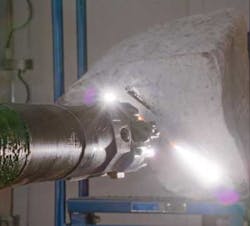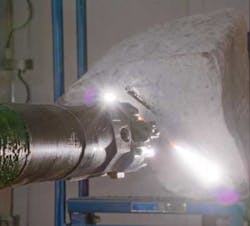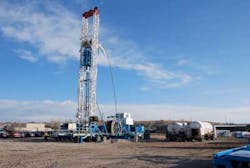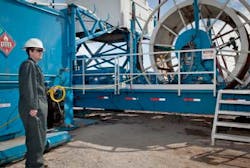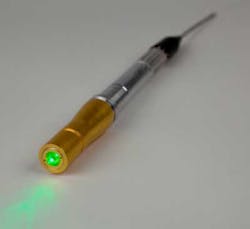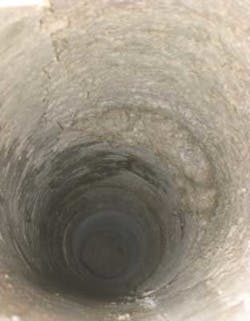High-power lasers in the energy industry
More Industrial Laser Solutions Articles |
A high-power diode laser primer Improving laser cutting with fiber choice The hole story: Femtosecond manufacturing improves automobile fuel efficiency |
FIGURE 1. Test firing of the 20 kW laser-mechanical drill bit, as integrated into the commercial coil tube drilling rig.
The laser hardware platform was integrated into a coil tube drilling rig to create the laser-mechanical drilling system show in FIGURES 2 and 3. This integration included the packaging of the laser system, the rewiring of the rig control system to include all of the laser safety interlocks, the packaging of the fiber optic, and the integration of the optical system into a down-hole drilling assembly.
FIGURE 2. Foro Energy's field drilling test site, with its integrated coil tube laser-mechanical drilling rig's 75-foot mast extended for the drilling test.
FIGURE 3. The optical fiber (yellow) extending from Foro Energy's field laser container and interfacing with the hub of the 12-foot-diameter reel on the integrated coil tube laser-mechanical drilling.
The first component in the laser power transmission system, the 20 kW fiber laser, is packaged in an environmentally controlled container that was drop-shipped to the site. The laser and its support equipment receive electrical power from a diesel-powered electrical generator. The output of the 20 kW fiber laser is through a standard industrial-grade optical fiber which routes the power from the laser to an optical slip ring mounted in the hub of the coil tube reel (FIGURE 4). The slip ring allows the hub to rotate without interrupting the optical power transmission down-hole. As the borehole is drilled the coil tube reel rotates, feeding out the 2-7/8 in. coil tubing which contains the optical transmission cable, advancing both into the deepening borehole and continuously providing laser power to the bottom hole drilling system.
FIGURE 4. The 20 kW down-hole fiber optic connector.
The optical transmission cable is an optical fiber packaged in a multi-wall stainless steel tube to protect it in the high-pressure, high-temperature, high-shock, and high-abrasion down-hole environment. The stainless steel tube is designed to withstand 20,000 psi of pressure, and the fiber is packaged in a high-temperature gel to support the fiber in a vertical position and dampen high-g shocks. The transmission cable met all of the harsh environmental requirements necessary for a field-ready power transmission system. The packaged fiber was successfully tested at 400°F for a period of 24 hours with up to 20 kW of laser power launched into the fiber. The packaged fiber then successfully withstood 200 g of vibration for a period of 24 hours. With up to 20 kW of power being launched into the fiber throughout these tests, there were no significant changes observed in the output power, the output mode, or the output numerical aperture.
A high-power connector terminates the optical fiber down-hole and meets all of the requirements necessary to perform laser-mechanical drilling in the field. The connector was designed to operate at 20 kW power levels, at elevated temperatures, in a high-g shock environment, and without the need for liquid cooling. The connector was thermally compensated for the high-temperature environment, as well as mechanically compensated for the high-shock environment. The connector successfully delivered 20 kW laser power to the down-hole tool in the borehole at high ambient temperatures and in a high-shock environment.
Prior to the down-hole tests, the connector was operated for several hours at 20 kW and up to 400°F with no external cooling. The connector was mounted on the distal end of a long optical fiber to enable the output power, mode shape, and numerical aperture to be monitored during the tests. After several hours of operation, all of the laser output characteristics were unchanged validating the robustness of the thermal-mechanical design.
The connector was first tested with a vibration table and a drop test prior to being operated for 24 hours inside of the drilling system under 200 g's of constant vibration and shock. The vibration table subjected the connector to a 250 g rms vibration for several hours. The transmission characteristics, mode quality, and NA from the connector were constantly measured and found to be unchanged. The connector was also subjected to a 6-ft. drop test onto concrete, this test was repeated multiple times, each time checking the transmission characteristics, mode quality, and NA from the connector. The output beam characteristics were found to be unchanged after this series of g tests, validating the robustness of the mechanical design.
The integrated coil tube laser-mechanical drilling system successfully drilled through ultra-hard crystalline rock (>30,000 psi unconfined compressive strength). During this test, the power was delivered by the optical transmission cable from the laser to the bottom of the borehole for extended periods of time (FIGURE 5).
FIGURE 5. Borehole drilled at the field drilling test site with the integrated coil tube laser-mechanical drilling rig.
Foro Energy setout to break several paradigms, and develop a rugged field ready laser hardware platform that can deliver high-power laser energy over long distances for applications in the oil, gas, geothermal, and mining industries. They have now proven this platform's ability to transmit high laser power over long distances, and established that this platform can meet the harsh environmental requirements of these industries. Integrating this platform into a commercial off-the-shelf drilling rig resulted in the drilling of the first subsurface borehole using a laser-mechanical drilling system.
They are working with a set of industry partners to develop many other applications for its laser hardware platform in the oil, gas, geothermal, and mining industries.
Foro Energy's successes were made possible by the dedication of a unique team of people made up of engineers from the laser and energy services industries at their Colorado and Texas facilities. Special thanks to both the Colorado School of Mines for its assistance analyzing the rock samples during the process development, and the US Department of Energy ARPA-E which provided matched cost-sharing to develop more economical drilling methods for geothermal wells.
Dr. Mark S. Zediker ([email protected]), Brian O. Faircloth, and Dr. Joel F. Moxley are with Foro Energy, Inc.2, Littleton, Colorado & Houston, Texas.
[1] Interview with Secretary Chu, Feb 24, 2012. This material is based upon work supported by the Department of Energy, ARPA-E, under Award Number AR0000044. Disclaimer: This report was prepared as an account of work sponsored by an agency of the United States Government. Neither the United States Government nor any agency thereof, nor any of their employees, makes any warranty, express or implied, or assumes any legal liability or responsibility for the accuracy, completeness, or usefulness of any information, apparatus, product, or process disclosed, or represents that its use would not infringe privately owned rights. Reference herein to any specific commercial product, process, or service by trade name, trademark, manufacturer, or otherwise does not necessarily constitute or imply its endorsement, recommendation, or favoring by the United States Government or any agency thereof. The views and opinions of authors expressed herein do not necessarily state or reflect those of the United States Government or any agency thereof.
[2] Copyright Foro Energy Inc., 2012
